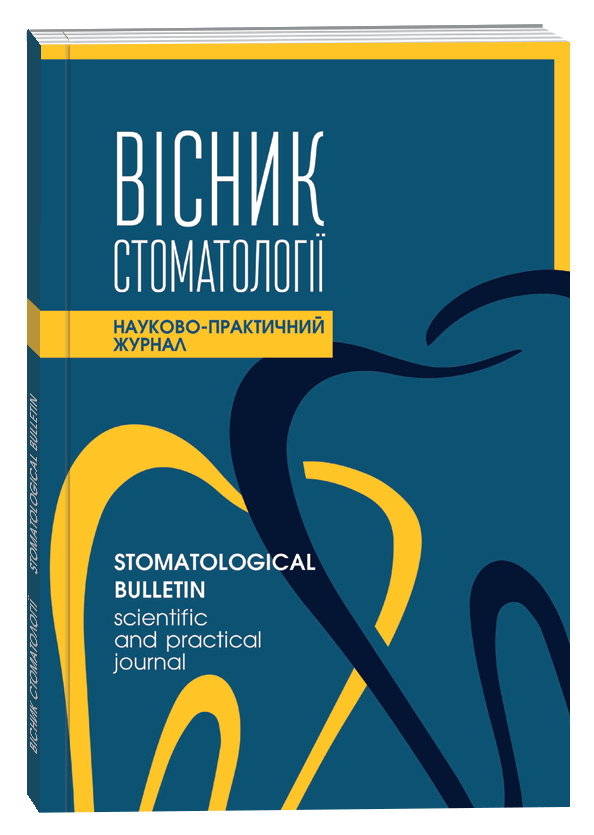ASSESSMENT OF THE EFFECTIVENESS OF A COMPLEX OF MEDICAL AND PREVENTIVE MEASURES THAT CONTRIBUTE TO A DECREASE IN THE INTENSITY OF TOOTH DAMAGE WITH CARIES IN PERSONS WHO HAVE HAD COVID-1
DOI:
https://doi.org/10.35220/2078-8916-2023-48-2.6Keywords:
COVID-19, caries, hyposalivation, treatmentAbstract
Purpose of the study. Development of a set of therapeutic and preventive measures that help reduce the intensity of dental caries damage in people who have had COVID-19. Research materials and methods. The studies involved 38 patients with mild to moderate COVID-19 (24 women and 14 men) aged 32-43 years who had had covid-19 in the range of 5-6 months ago. Patients were proportionally divided into 2 groups, both by gender, age, and time elapsed after illness The comparison group had 14 people (mean age 36±3,7let); the main group consisted of 20 individuals (mean age 37±4.1 years). Results. Patients of the main group were offered a treatment and preventive program, which includes 3 directions and is designed for 1 year. 1. Stimulation of salivation. Due to the fact that patients had grade 1-2 hyposalivation and there were no cases of xerostomia to increase saliva production, only reflex agents were prescribed for the salivary glands, namely, peppermint infusion. The drug was consumed internally for food 10-15 drops of tincture 2 times a day with a repetition frequency of 1 week per month. 2. Higher saliva mineralizing potential. A Sorbet Revive remineralizing gel comprising calcium chloride 0.2 %, sodium fluoride 0.005 %, potassium chloride 0.005% was administered. The gel was applied as applications to the teeth once a day after morning brushing. Exposure 50-60 seconds. 3. A special oral health care program. Daily 2-time brushing of teeth 2 times a day (morning and evening) with the use of toothpaste "Liquid Calcium" and a lowabrasive toothbrush of the "Sensitive" type. Studies have shown that treatment has led to improved oral hygiene, increased salivation, decreased acidity of oral fluid, with a simultaneous increase in the number of full crystalprismatic structures in it and, as a result, an increase in the mineralizing potential of oral fluid and a decrease in the intensity of dental involvement with caries
References
World Health Organization. (2020). Laboratory testing for coronavirus disease 2019 (COVID-19) in suspected human cases: interim guidance, 2 March 2020. World Health Organization.
Sharma Anshika, Farouk Isra Ahmad, & LalSunil Kumar (2021). COVID-19: A Review on the Novel Coronavirus Disease Evolution, Transmission, Detection, Control and Prevention.Viruses, 13(2): 202. Published online 2021 Jan 29. doi: 10.3390/v13020202.
Dhama Kuldeep, Khan Sharun, Tiwari Ruchi & et al. (2020). Coronavirus Disease 2019–COVID-19.Clin Microbiol Rev. 2020 Oct; 33(4): e00028-20. Published online 24. doi: 10.1128/CMR.00028-20.
David Herrera, Jorge Serrano, Silvia Roldán, & Mariano Sanz (2020). Is the oral cavity relevant in SARSCoV-2 pandemic? Clin Oral Investig, 24(8):2925-2930. doi: 10.1007/s00784-020-03413-2.
Huang Ni, Pérez Paola, KatoTakafumi & et al. (2021). SARS-CoV-2 infection of the oral cavity and saliva, 27(5): 892–903. doi: 10.1038/s41591-021-01296-8.
Neuberger Michael, Jungbluth Achim ,Irlbeck Michael & et al. (2022). Duodenal tropism of SARS-CoV-2 and clinical findings in critically ill COVID-19 patients.Infection, 50(5): 1111–1120. doi: 10.1007/s15010-022-01769-z
Mustafa Nada F., JafriNadim S, HoltorfHeidi L., & ShahShinil K. (2021). Acute oesophageal necrosis in a patient with recent SARS-CoV-2. BMJ Case 14(8): e244164. Published online 2021 Aug 16. doi: 10.1136/bcr-2021-244164.
Drozdzik Agnieszka, & Drozdzik Marek (2022). Oral Pathology in COVID-19 and SARS-CoV-2 Infection–Molecular Aspects. Int J Mol Sci., 23(3): 1431. doi: 10.3390/ijms23031431.
Huang, N., Pérez, P., Kato, T., Mikami, Y., Okuda, K., Gilmore, R.C., Conde, C.D., Gasmi, B., Stein, S., Beach, M., &et al. (2021). SARS-CoV-2 infection of the oral cavity and saliva. Nat. Med., 27, 892–903.
Pingping Han, & Sašo Ivanovski (2020). Saliva–Friend and Foe in the COVID-19 Outbreak.Diagnostics (Basel), 10(5), 290. doi: 10.3390/diagnostics10050290.
Poyan Barabari, & Keyvan Moharamzadeh Novel (2020). Coronavirus (COVID-19) and Dentistry–A Comprehensive Review of Literature Dent J (Basel), 8(2), 53 doi: 10.3390/dj8020053.
Huang Ni, Pérez Paola, KatoTakafumi & et al. (2021). SARS-CoV-2 infection of the oral cavity and saliva. Nat Med. Author manuscript; available in PMC 27(5): 892–903. 25. doi: 10.1038/s41591-021-01296-8.
Matuck B.F., Dolhnikoff M., Duarte-Neto A.N., Maia G., Gomes S.C., Sendyk D.I., Zarpellon A., de Andrade N.P., Monteiro R.A., Pinho J.R.R., & et al. (2021). Salivary glands are a target for SARS-CoV-2: A source for saliva contamination. J. Pathol., 254, 239–243. doi: 10.1002/path.5679.
Azzi, L., Maurino, V., Baj, A. & et al. (2020). Diagnostic Salivary Tests for SARS-CoV-2 J Dent Res, 0022034520969670. doi: 10.1177/0022034520969670.
Zhu, F., Zhong, Y., Ji, H., Ge, R., Guo, L., Song, H., Wu, H., Jiao, P., Li, S., Wang, C., & et al. (2022). ACE2 and TMPRSS2 in human saliva can adsorb to the oral mucosal epithelium. J. Anat. 240:398–409. doi: 10.1111/joa.









